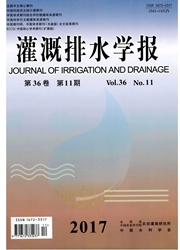

 中文摘要:
中文摘要:
以黄淮海平原地下微咸水为研究材料,通过实验室模拟,采用冻融法,研究地下微咸水冰晶融冻过程中融水含盐量以及离子动态变化特征及其之间的相互关系。结果表明,融冰初期(进程10%)融水含盐量高达14.71g/L。随着融冻进程融水含盐量及Cl^-、SO4^2-、CO3^2-、HCO3^-、Na^+、Mg^2+、K^+等离子均呈逐渐递减趋势,且与融解进程呈极显著指数相关(P〈0.01),相关程度均达90%以上;Ca^2+则呈现先增加后降低的趋势,与融冰进程呈显著抛物线关系。当500mL地下咸水冰晶融解掉79mL水后,剩余水含盐量将会低于2g/L,融掉216.5mL时,可将盐分控制在1g/L以下。融冰前期,离子主要以Na+、Mg2+、Cl-为主,随着融冻进程逐渐演变为以Na^+、Mg^2+、Cl^-、SO24-为主。地下咸水冰晶融冻时含盐量与离子变化具有高度一致性,冰晶融冻技术可达到地下咸水脱盐和控制离子组成的双重目的。
 英文摘要:
英文摘要:
Simulated experiment about saline groundwater was conducted using the method of melting,to analyze dynamic of salinity and ion concentrations in the melting process,and the relationship among salt and ion content in melt water.The results showed that the salinity of the melt-water was up to 14.71 g/L at the beginning of melting ice.But with the process of melting saline ice,the saline and ion content,such as Cl^-,SO4^2-,CO3^2-,HCO3^-,Na^+,Mg^2+,and K^+ in the melt water gradually decreased,and showed highly significant exponential correlation with the melting process(P0.01) with the R2 of more than 90%.While for Ca^2+,the concentration increased at first and then decreased,showed significant parabolic relationship.From model calculated,after melting 79 mL water of 500 mL,the surplus ice salinity would be less than 2 g/L,which was the criterion of agricultural irrigation.While melting 216.5 mL,the salinity would be less than 1 g/L.At the beginning of melting ice,the major ions in the melt water were Na+,Mg2+,and Cl^-,but at last,the major ions consisted of Na^+,Mg^2+,Cl^-,and SO4^2-.The salinity in melt water has highly significant positive correction with Cl^-,CO3^2-,HCO3^-1,Na^+,Mg^2+,and significant positive relationship with SO4^2-,but has significant negative correction with Ca^2+.The dynamic characteristic of the salinity show high consisted with ion content in the process of melting ice,and underground saline water desalination could be achieved.
 同期刊论文项目
同期刊论文项目
 同项目期刊论文
同项目期刊论文
 期刊信息
期刊信息
